Peter Beauclerk-Dewar presents his family history as a
straightforward tale of unremarkable, hard-working, responsible Highlanders.
They made few headlines but, over the centuries, built on their skills and
experience and went on to exploit the opportunities arising from union with
England and the development of trade and industry. However there is much
more to it than that. Several members of his family made notable
contributions in their time to civic, sporting and military life. Meanwhile,
through his mother, Peter is a direct descendant of Charles II and his famed
mistress Nell Gwyn – hardly unremarkable…
There are also some colourful-sounding conundrums in
Peter's family's past. How did it arise that a relatively modest family of
shoemakers should have had a family crest and arms? What did John Dewar and
his apprentice Andrew Yuill get up to in 1710 to be fined £50 each – an
enormous sum in those days – for "blood and riot"? Why did John
grant a 'Charter of Alienation and Sasine' to his brother Patrick in 1714,
leading the latter to obtain his house and lands? And what were the
circumstances that later led Patrick to be on the receiving end of another
episode of "blood and riot", this time initiated by a certain John
Glen whom Patrick sued, receiving damages of some £3?
Regrettably a dearth of information in the records means
the stories behind these events may never be known.
Exploring family history
Peter Beauclerk-Dewar explains that his interest in his
family history was aroused almost by chance when, on his twenty-first
birthday, he was given a signet ring handed down through generations of his
family. "My father, who was so punctilious in so many things, seemed to
know remarkably little about it, so I took up the challenge to find out
more. First I approached the College of Arms in London. There I was told
that the crest belonged to the family of Dewars of Vogrie. My quest then led
me to Scotland and to Stirling where I visited Cambuskenneth and the Church
of Holy Rude where there is an early family tomb dated 1705. From there I
was able gradually to put together the different pieces of the family
jigsaw.
"I subsequently discovered that my family is probably
the largest family of Dewars on record – with branches on all five
continents of the world. Through my research I identified, made contact
with, and in some cases met, a great many different cousins worldwide that I
never knew I had. It has put me in touch with literally hundreds of people,
which I have enjoyed tremendously.
"Although there were Dewars in Stirling from 1483,
our earliest known direct ancestor was a Patrick or Peter Dewar (the two
names are interchangeable). In 1671 he lived as a tenant in the village or
hamlet of Cambuskenneth, on the opposite side of the River Forth from
Stirling.
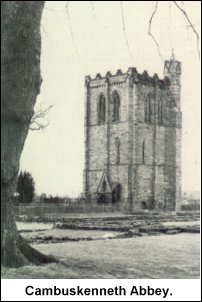 "Cambuskenneth
Abbey is well known and a site of considerable historical interest. Founded
in 1140 by King David I, it was one of the great Augustinian Monasteries.
Some two centuries later King David's great-great-great-grandson, King
Robert the Bruce, convened several parliaments in the abbey, notably in 1314
after the Battle of Bannockburn. In 1488 King Robert's great-great-great
grandson, King James III, was buried there, alongside his wife Queen
Margaret, following his death at the battle of Sauchieburn nearby. Sadly,
today only the Abbey bell-tower remains.
"Cambuskenneth
Abbey is well known and a site of considerable historical interest. Founded
in 1140 by King David I, it was one of the great Augustinian Monasteries.
Some two centuries later King David's great-great-great-grandson, King
Robert the Bruce, convened several parliaments in the abbey, notably in 1314
after the Battle of Bannockburn. In 1488 King Robert's great-great-great
grandson, King James III, was buried there, alongside his wife Queen
Margaret, following his death at the battle of Sauchieburn nearby. Sadly,
today only the Abbey bell-tower remains.
"Returning to my family, we know that Patrick Dewar
had two sons, John and Patrick (the latter being my direct ancestor), both
of whom were cordiners or shoemakers, as also were a number of their
descendants. As qualified craftsmen, these Dewars were members of the Royal
Incorporation of Shoemakers of Stirling, one of the craftsmen's guilds of
the time.
"By 1713 Patrick, the younger of the two, was well
established enough to have been able to lend 200 merks to the Incorporation
of Fleshers of Stirling. Intriguingly, while presumably an upstanding member
of the Royal Incorporation of Shoemakers of Stirling, he is also described
in Burke's Landed Gentry as having 'defied the Deacon, Dean of Guild
and Bailie of the Royal Incorporation of Shoemakers of Stirling as to buying
of new shoe leather'.
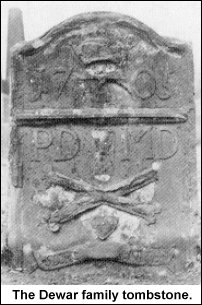 "It
was Patrick who, in 1705, had erected the family tombstone at the Church of
Holy Rude in Stirling, inscribing it with the arms of Dewar. Perhaps the
seeming mystery of why a modest family of shoemakers should have had a
family crest and arms may be explained by the considerable variations in
wealth and status which could (and still can) exist within one family in
countries such as Scotland where primogeniture prevails. When the eldest
sons inherit all, junior branches frequently need to fend for themselves;
but they remain entitled to matriculate an individual variation of their
family arms."
"It
was Patrick who, in 1705, had erected the family tombstone at the Church of
Holy Rude in Stirling, inscribing it with the arms of Dewar. Perhaps the
seeming mystery of why a modest family of shoemakers should have had a
family crest and arms may be explained by the considerable variations in
wealth and status which could (and still can) exist within one family in
countries such as Scotland where primogeniture prevails. When the eldest
sons inherit all, junior branches frequently need to fend for themselves;
but they remain entitled to matriculate an individual variation of their
family arms."
Farmers, grain merchants and oarsmen
Over the course of the eighteenth and nineteenth centuries
the Dewars made the transition from their trade as cordiners to
become successful farmers and grain merchants. Patrick's great-grandson and
namesake was the first to do so, becoming a farmer at Cornton outside
Stirling in the mid-eighteenth century. He was nominated a Burgess of
Stirling, a position of some standing in the community, and he and his
descendants went on to farm no fewer than ten farms encircling Stirling.
Patrick's son Peter, also a Burgess of Stirling as were several other family
members, was a prominent farmer and Crown tenant of King's Park.
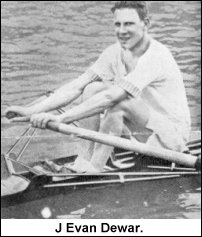 "Several
separate branches of the family then, quite independently, took up grain
merchanting," notes Peter. "The most successful of these was my
great-grandfather, James Dewar, the youngest son of Peter Dewar of
Craigniven and King's Park. James was the youngest son and would not inherit
the family business, so he left Stirling for London to seek his fortune.
There, building on his knowledge and experience of cereal farming, he
co-founded a firm called Dewar & Webb in 1872. The company soon also had
branches in Portland, Oregon and the American Press of the day rather
charmingly dubbed him 'King Corn'.
"Several
separate branches of the family then, quite independently, took up grain
merchanting," notes Peter. "The most successful of these was my
great-grandfather, James Dewar, the youngest son of Peter Dewar of
Craigniven and King's Park. James was the youngest son and would not inherit
the family business, so he left Stirling for London to seek his fortune.
There, building on his knowledge and experience of cereal farming, he
co-founded a firm called Dewar & Webb in 1872. The company soon also had
branches in Portland, Oregon and the American Press of the day rather
charmingly dubbed him 'King Corn'.
"James was a member of the Baltic Exchange, a Freeman
of the City of London and a Liveryman of the Worshipful Company of Bakers
(he became Master in 1906). In his spare time, he was a keen oarsman and a
member of the London Rowing Club, an interest he shared with his two sons,
Peter and James Evan (known as Evan). They in their turn went 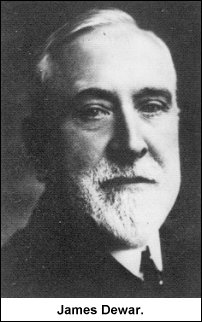 on
to become leading lights in London rowing circles. Peter represented Great
Britain in the Olympic Games in 1908 and Evan rowed in the Diamond Sculls in
1910 and 1911.
on
to become leading lights in London rowing circles. Peter represented Great
Britain in the Olympic Games in 1908 and Evan rowed in the Diamond Sculls in
1910 and 1911.
"Peter, the elder son, eventually took over Dewar
& Webb which he subsequently sold. He then went out to Kenya where he
lived for the rest of his life. His son by his first marriage, David, served
as a captain in the Kenya Regiment during the Mau Mau uprisings of the
1950s, and is now a farmer in Ayrshire where he is factor of Lord Inchcape's
Glenapp estate. David is the current head of our branch of the family."
A story of bravery
"Evan, my grandfather, served in World War I in the
London Rifle Brigade and was killed in action at Lesboeufs, France in 1916.
He left an only son James who, as a pilot officer in Coastal Command Flying
Boats 204 Squadron in World War II, was among the first of those to be
awarded the George Medal for bravery (the George Medal like the George Cross
was instituted in 1940 by King George VI). This he received for saving the
lives of several injured members of the crew of his Sunderland flying boat
after it had crashed into a mountainside in Iceland. Four crew members
including the captain were seriously injured. James and other crew members
managed to carry the wounded clear of the wrecked hull just before it caught
fire; moments later the bombs it was carrying exploded.
"The captain's injury meant that James, as second
pilot, took charge. He and a volunteer went to find help from the village
below the mountain, walking for ten miles down through the lava desert that
was the mountainside, their rubber flying boots torn to shreds.
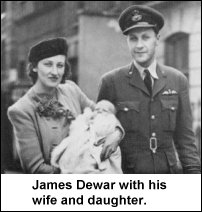 "The
alarm was raised and a rescue party of lorries and ambulances assembled, but
was unable to cross the lava beds. The rescuers had to continue on foot and
my father volunteered to lead the way; he then had to trek back to the
village on foot yet again.
"The
alarm was raised and a rescue party of lorries and ambulances assembled, but
was unable to cross the lava beds. The rescuers had to continue on foot and
my father volunteered to lead the way; he then had to trek back to the
village on foot yet again.
"Some months later my father was appointed to the
General School of Air Reconnaissance where he played a major role in the
invention and development of an important flying and navigation training aid
which was subsequently adopted by many air forces and airlines. He was
mentioned in despatches and in 1946 he was awarded the MBE."
A Cavalier ancestry
"Through my father's marriage to Hermione de Vere
Beauclerk, I can also boast a wonderfully Cavalier ancestry. My maternal
grandfather was heir-in-line to the Dukedom of St Albans – Charles
Beauclerk, Duke of St. Albans having been the first son of the liaison
between Charles II and the actress Nell Gwyn, and one of fourteen
acknowledged illegitimate children of Charles II – a notoriously
flamboyant and colourful character.
"Nell Gwyn was said to be by far the most popular of
all the king's mistresses – largely because of her ready wit but perhaps
also because she was beautiful and never put on airs and graces, never
forgot old friends, and remained faithful to her 'Charles III' (he
was her third lover of that name) to the end.
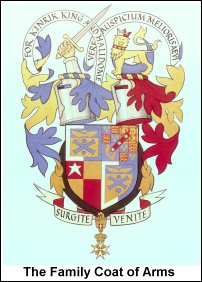 "In
1965 I presented the details of, and evidence supporting, all these chapters
in our family history to the Lord Lyon King of Arms in Edinburgh, seeking
confirmation and registration. He permitted me to matriculate arms,
quartering my Dewar arms 'of ancient user' (the Lord Lyon King of Arms
believed these dated back to the early 1500s), as on the seventeenth-century
tombstone, with those of the Beauclerks, Dukes of St. Albans, and the de
Veres, Earls of Oxford, reflecting my mother's status of heraldic heiress.
Thus my arms are a sort of pictorial genealogy, signifying both my maternal
descent from Charles II and Nell Gwyn and my paternal descent from Dewar.
"In
1965 I presented the details of, and evidence supporting, all these chapters
in our family history to the Lord Lyon King of Arms in Edinburgh, seeking
confirmation and registration. He permitted me to matriculate arms,
quartering my Dewar arms 'of ancient user' (the Lord Lyon King of Arms
believed these dated back to the early 1500s), as on the seventeenth-century
tombstone, with those of the Beauclerks, Dukes of St. Albans, and the de
Veres, Earls of Oxford, reflecting my mother's status of heraldic heiress.
Thus my arms are a sort of pictorial genealogy, signifying both my maternal
descent from Charles II and Nell Gwyn and my paternal descent from Dewar.
"In keeping with Scottish heraldry, it is interesting
to note that my Dewar arms bear strong similarities to those of all other
Dewar families in Scotland. However, we have been unable to establish any
connection between them, despite undertaking considerable research.
"My strong interest in genealogy led to my
specialisation in this field of study and I founded a heraldic and
genealogical practice more than thirty years ago. Since then I have become
increasingly involved in lecturing and writing, as the heraldry consultant
to Christie's and numerous other similar activities which I undertake in
addition to my main occupation as an accountant, management consultant,
'headhunter' and magistrate. From 1965 until 1992 I also served as a
Lieutenant Commander in the Royal Navy Reserve, latterly in naval
intelligence which I see as requiring many of the same investigative and
presentational skills used in genealogy."
Maintaining tradition
"More traditional roles include my membership of the
Royal Company of Archers which acts as the Queen's personal bodyguard when
she's in Scotland. We don marvellous green uniforms, wear feathers in our
caps and bear bows and arrows. Although the Royal Company dates back to
1676, its role as the Royal Body Guard commenced in 1821. Its presence at
the Royal Garden Party at Holyrood, at Investitures and at the Thistle
Service adds a splash of colour and romanticism.
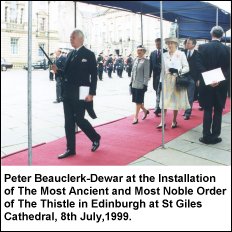 "I
have also served as Falkland Pursuivant Extraordinary to the Lord Lyon King
of Arms on numerous occasions since 1975, in connection with the Service of
Installation of Knights and Dames of the Most Noble and Most Ancient Order
of the Thistle. This ceremonial role involves leading in the procession of
the Royal Household. In July this year I shall again be acting as Falkland,
for the twelfth time, when the Queen is to invest the Princess Royal as a
Dame of the Thistle in St. Giles' Cathedral.
"I
have also served as Falkland Pursuivant Extraordinary to the Lord Lyon King
of Arms on numerous occasions since 1975, in connection with the Service of
Installation of Knights and Dames of the Most Noble and Most Ancient Order
of the Thistle. This ceremonial role involves leading in the procession of
the Royal Household. In July this year I shall again be acting as Falkland,
for the twelfth time, when the Queen is to invest the Princess Royal as a
Dame of the Thistle in St. Giles' Cathedral.
"In addition I am a Liveryman of the Worshipful
Company of Haberdashers which ranks eighth among the 'Great Twelve' Livery
Companies of the City of London (there are a hundred or so in total), and
dates back to pre-1468. My earliest traceable ancestors were members of not
dissimilar guilds, so the family has perhaps now gone full circle. Today,
though, most of the livery companies are much less involved in the trades
from which they take their names, and more in the charities they support
such as schools.
"Over the last year I have been particularly involved
in researching and editing the new edition of Burke's
Landed Gentry, in the exciting prospect of getting this on to the
Internet. This is a marvellous initiative as it will enable us continually
to update, correct and improve on the hundreds of family and thousands of
individual entries making up the directory, creating a vast online research
resource. It also means we shall be able to use colour liberally – the
first time we have been able to do so. For instance, we shall be able to
show each generation in a different colour, which will make it far easier to
follow and be more 'user-friendly' than the traditional indentations. As far
as we are aware, we shall be the first genealogical or reference resource to
use colour in this way.
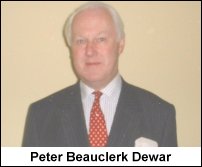 "Finally, where my own family is concerned, for many
years I have owned the tiny Scottish island of Holm of Huip, by Stronsay, in
the Orkney Islands. This once formed part of the dowry brought by Margaret,
daughter of King Christian of Denmark, upon her marriage to King James III
of Scotland in 1469. Both Margaret and James are my thirteen times
great-grandparents on my mother's side, and both are buried at Cambuskenneth
Abbey. So again perhaps the wheel has come full circle, but is this not what
history is all about?"
"Finally, where my own family is concerned, for many
years I have owned the tiny Scottish island of Holm of Huip, by Stronsay, in
the Orkney Islands. This once formed part of the dowry brought by Margaret,
daughter of King Christian of Denmark, upon her marriage to King James III
of Scotland in 1469. Both Margaret and James are my thirteen times
great-grandparents on my mother's side, and both are buried at Cambuskenneth
Abbey. So again perhaps the wheel has come full circle, but is this not what
history is all about?"
In 1975 Peter Beauclerk-Dewar published his first book, The
House of Nell Gwyn – the fortunes of the Beauclerk Family 1670-1974
(co-authored with Donald Adamson). He is also the author of The House of
Dewar 1296-1991 and The Family History Record Book (1991), and
editorial director of Burke's Landed Gentry 2001.

